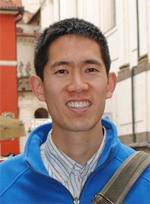Research Computing Showcase
Summer 2017
“Utilizing Machine Learning Tools on Supercomputers”
Timothy J. Tsai, Assistant Professor of Engineering

- What is your research about?
Our research is about using machine learning tools to identify a song at a live concert based on a short, noisy cell phone recording.
- What kind of computations do you do for the research?
There has been a surge of interest in a field called deep learning, where the goal is to train a neural network to make predictions. We are trying to apply deep learning to the live song identification problem. In order to learn a deep neural network, we need to do a lot of matrix computations on a large amount of data. These computations can take a long time, so using supercomputing clusters can greatly accelerate the speed of these experiments.
- How (and when) did you start using XSEDE resources and in what ways, have the resources helped your research?
We started using the XSEDE resources this summer. The XSEDE resources have greatly benefited our research in two ways: (1) it enables us to run many experiments in parallel, and (2) it enables us to run experiments much more quickly by using specialized GPUs, which can accelerate the time it takes to complete an experiment by a factor of 10. Because we can run many more experiments, we are able to gain insights far more quickly. What would have taken a week on a single server only takes a few hours on the XSEDE supercomputing clusters.
- What do you think about the research computing support CIS offers?
XSEDE is a fantastic program and allows HMC to do computational research that is competitive with universities. The training seminars that I have attended have been very helpful.
“Comparing Density Functional Theory with Experimental Results of Claisen Rearrangements”
Gabriel Phun ’18, Chemistry
 What was your research activity during this summer about?
What was your research activity during this summer about?
Please see my “research nugget” that gives a very concise overview of my research. [2017 Summer Research Poster]
- How were you introduced to the supercomputing resources and how have you been supported from CIS for your activities?
I was introduced to supercomputing the summer after my Freshman year (I think 2015?) with an XSEDE workshop. I was reminded/reintroduced this summer after my Junior year again with an XSEDE workshop. The workshop was helpful because it showed me how to run jobs and how to log into Comet. I also got tremendous support from you with troubleshooting and running cpu as well as gpu jobs. You and Claire Connelly also helped me with writing scripts which made it easier to be organized and efficient when running multiple jobs.
- How did you use the XSEDE resources (e.g., how simulations you ran, how much time your simulations took, etc.) in your research?
In total I have run 150 jobs on XSEDE that took a total of 61,257.0 SUs (Overdrawn on SUs, I hope this is ok). Our allocation was 50,000 SUs. The median job wall run time is: 630 mins while the mean job wall run time is: 1090 mins.
- What have you learned from it and what’s the impact on your learning?
I’ve learned how to use unix command line and some very basics of shell scripts (the ones with .sh). With help I learned how to write a script that emails me when the job is finished running which is extremely cool and useful. XSEDE has also given me opportunity to do a large amount of these quantum chemistry computations which helps me become familiar with them. This especially helps me because I am looking into grad school and I want to eventually work on quantum chemistry computations.
- Do you have future plans to use the supercomputers if any?
For my senior thesis I will be continuing/expanding on my summer research. So I will be doing a lot more computations in the fall and spring semesters. I think Prof. Cave and Prof. Daub are going to write something with your help to get a lot more allocation time on XSEDE.